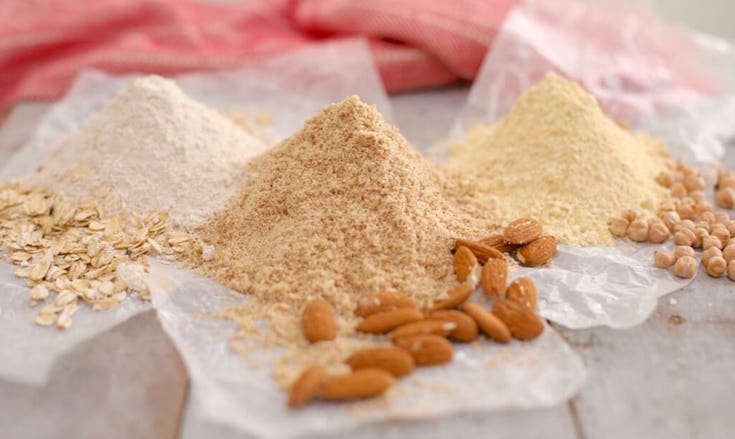Perhaps you probably know someone, or have even tried a gluten-free diet yourself in recent years. The popularity of this diet has led to the creation of a variety of gluten-free products whereby gluten-free options are now widely available on restaurant menus. These are the 6 healthiest gluten-free flours you can consider if you are on a gluten-free diet.

It is estimated that approximately 1% of the population in Western countries is diagnosed with celiac disease, an autoimmune condition triggered by the consumption of gluten from wheat, rye and barley flours that leads to the destruction of the intestinal lining and malabsorption of nutrients.
Non-celiac gluten sensitivity (NCGS), which is gluten sensitivity in the absence of celiac disease, affects approximately 13% of the population.
Signs that you may have non-celiac gluten sensitivity include:
- Brain fog.
- Fatigue.
- Dizziness.
- Fibromyalgia.
- Skin problems.
- Headaches.
- To feel down.
- Nausea, vomiting.
- Digestive problems: cramps, diarrhea or constipation, bloating and gas.
But why does gluten sensitivity seem to be on the rise?
When we turn to science, we can’t really find an answer. There are many theories from the rise of modern wheat, to the overuse of antibiotics and pesticides, and that they are actually FODMAP and gluten-free.
But what if the answer is much simpler than that?
Refined flours and our health
The truth is that, as a population, we consume too many products made up of a single grain: wheat. Think about it: toast with eggs for breakfast, a sandwich for lunch, and a plate of pasta for dinner.
And, most of the gluten-based products on our menu are highly processed, refined, and devoid of nutrients.
When a grain is refined, the bran and germ, which are the most nutritious parts, are removed and what remains is the endosperm that contains most of the starch.
Refining a grain leaves us with a processed flour that is not only lacking in fiber, vitamins, minerals, and antioxidants, but something that increases our blood sugar levels and affects the health of our gut.
So could increase gluten sensitivity be the combination of many factors, and could the answer really lie with our microbiome and our gut health? Researchers are definitely exploring that connection.
Best gluten-free flours
The good news is, if you are gluten sensitive or intolerant, there are plenty of other healthy and nutritious flour options to try.
Almond flour
This is a flour that is at the top of our list. It is slightly sweet and is relatively easy to use as a replacement. It can generally be substituted 1: 1 for wheat flour in baking recipes and can also be used to make delicious bread crumbs. It’s denser and less fluffy than regular flour, but that makes for a delicious bread.
Almond flour is incredibly nutritious and rich in healthy fats, vitamin E, fiber, and magnesium.
Coconut flour
Coconut flour is rich in fiber and helps maintain constant blood sugar levels. It is perfect to use in baking and desserts due to the slight coconut flavor.
Coconut flour contains medium chain triglycerides (MCTs) that have a positive effect on metabolism and energy production.
It’s also a great option for those on a paleo or keto diet, and anyone with a nut allergy.
Chickpea flour
Chickpeas, rich in protein and fiber, are a staple in Middle Eastern cuisine. Chickpea flour is made from ground dried chickpeas and is generally used to make falafel and soccer bread.
Chickpea flour is incredibly nutritious and contains good amounts of folate, magnesium, zinc, selenium, and B vitamins. It helps stabilize blood sugar levels, protects against heart disease, reduces inflammation, and is beneficial for the intestine.
It can be used in both sweet and savory recipes.
Buckwheat flour
Buckwheat flour is quite nutritious and contains an important flavonoid called rutin with anti-inflammatory properties that help blood circulation, lower cholesterol, and help reduce arthritis pain.
As a flour, it is excellent when combined in recipes, as it has a strong earthy flavor.
Oatmeal
Oatmeal is made by grinding whole oats and makes a great cookie flour.
Oats contain a type of soluble fiber called beta-glucan that is best known for lowering bad “LDL” cholesterol. Oatmeal is also rich in manganese, selenium, magnesium, phosphorus, zinc, iron, and B vitamins.
Make sure the oatmeal you buy is certified gluten-free, as oats are generally contaminated during processing.
Cricket flour
An unconventional option that is definitely gaining popularity is cricket flour that is made by grinding whole roasted crickets. It is the new super nutritious and greener protein source.
12 grams of cricket flour has 7 grams of protein, including all 9 essential amino acids. It also has more B12 than salmon or beef, contains omega-3s, iron, and calcium, and is good for the gut!
Other gluten-free flour options
- Brown rice flour.
- Sorghum flour.
- Tiger meal.
- Teff flour.
- Amaranth flour.
- Cassava flour.
- Cornmeal.
Do you follow a gluten-free diet? What is your favorite flour?
Rustic almond flour bread
Ingredients:
- 2 cups of almond flour.
- ¼ cup tapioca flour.
- ½ teaspoon baking soda.
- 1 tablespoon garlic salt.
- 1 teaspoon dried oregano.
- 1 teaspoon ground black pepper.
- 3 eggs.
- ¼ cup almond milk.
- 1 tablespoon of ghee.
Preparation:
Preheat the oven to 180 ° C. In a large bowl, mix almond flour, tapioca flour, baking soda, salt, oregano and pepper.
In a separate bowl, mix the eggs, almond milk, and ghee. Pour the wet ingredients into the dry ones and stir to combine. The mixture will be thick.
Pour the batter into the loaf pan and bake for 1 hour.
